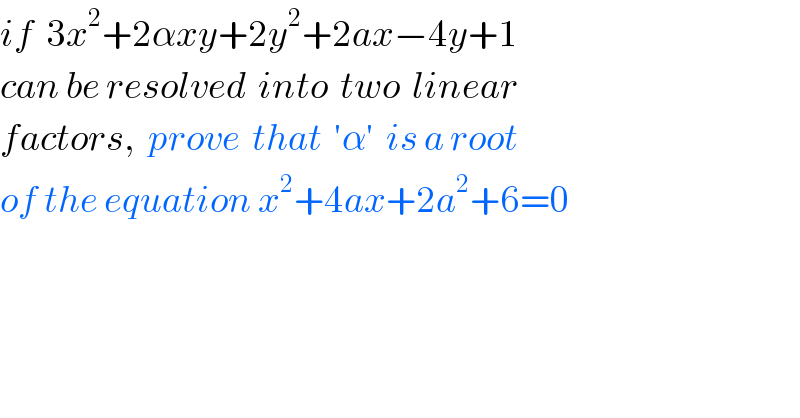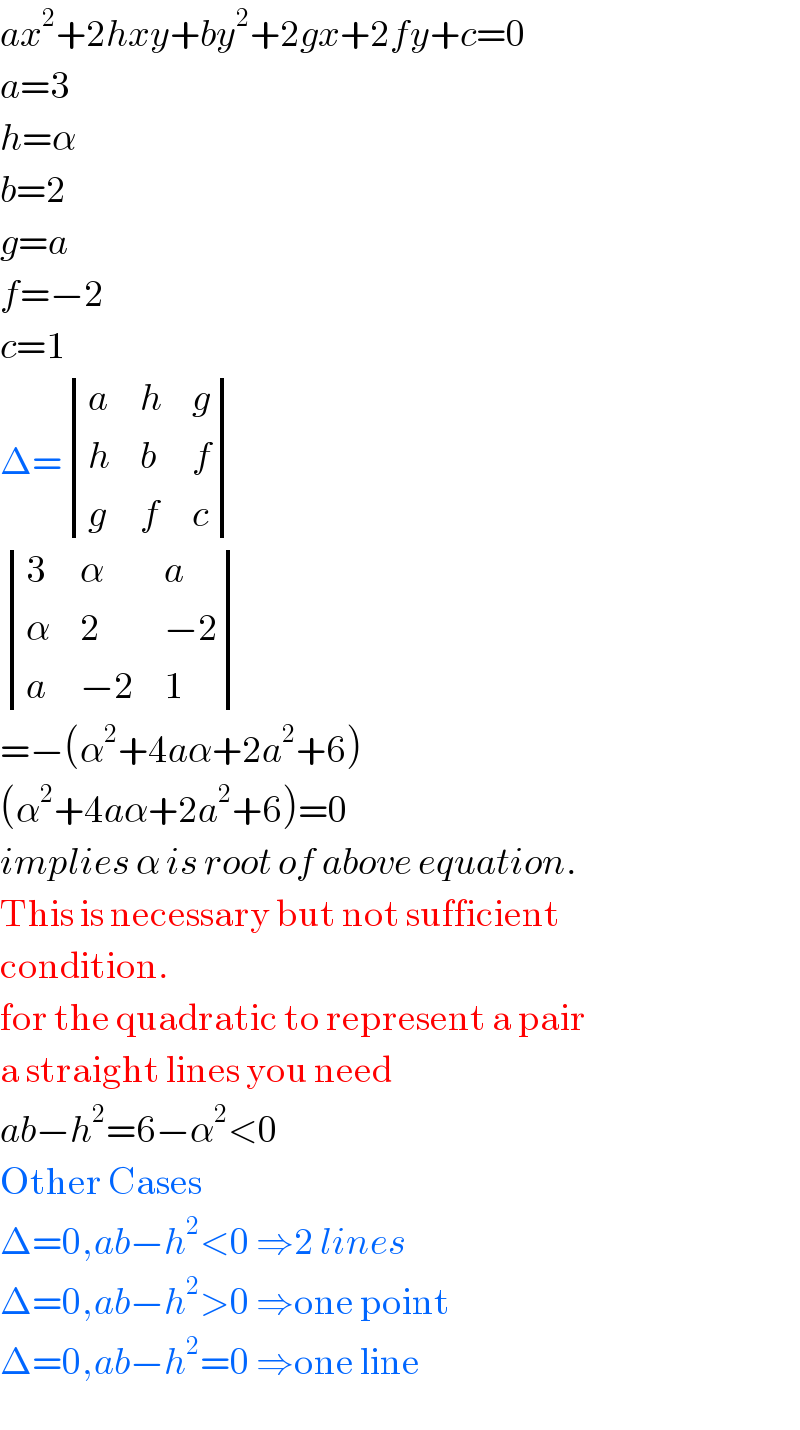Question Number 37166 by nishant last updated on 09/Jun/18

$${if}\:\:\mathrm{3}{x}^{\mathrm{2}} +\mathrm{2}\alpha{xy}+\mathrm{2}{y}^{\mathrm{2}} +\mathrm{2}{ax}−\mathrm{4}{y}+\mathrm{1} \\ $$$${can}\:{be}\:{resolved}\:\:{into}\:\:{two}\:\:{linear} \\ $$$${factors},\:\:{prove}\:\:{that}\:\:'\alpha'\:\:{is}\:{a}\:{root}\: \\ $$$${of}\:{the}\:{equation}\:{x}^{\mathrm{2}} +\mathrm{4}{ax}+\mathrm{2}{a}^{\mathrm{2}} +\mathrm{6}=\mathrm{0} \\ $$
Commented by prakash jain last updated on 10/Jun/18

$${ax}^{\mathrm{2}} +\mathrm{2}{hxy}+{by}^{\mathrm{2}} +\mathrm{2}{gx}+\mathrm{2}{fy}+{c}=\mathrm{0} \\ $$$${a}=\mathrm{3} \\ $$$${h}=\alpha \\ $$$${b}=\mathrm{2} \\ $$$${g}={a} \\ $$$${f}=−\mathrm{2} \\ $$$${c}=\mathrm{1} \\ $$$$\Delta=\begin{vmatrix}{{a}}&{{h}}&{{g}}\\{{h}}&{{b}}&{{f}}\\{{g}}&{{f}}&{{c}}\end{vmatrix} \\ $$$$\begin{vmatrix}{\mathrm{3}}&{\alpha}&{{a}}\\{\alpha}&{\mathrm{2}}&{−\mathrm{2}}\\{{a}}&{−\mathrm{2}}&{\mathrm{1}}\end{vmatrix} \\ $$$$=−\left(\alpha^{\mathrm{2}} +\mathrm{4}{a}\alpha+\mathrm{2}{a}^{\mathrm{2}} +\mathrm{6}\right) \\ $$$$\left(\alpha^{\mathrm{2}} +\mathrm{4}{a}\alpha+\mathrm{2}{a}^{\mathrm{2}} +\mathrm{6}\right)=\mathrm{0} \\ $$$${implies}\:\alpha\:{is}\:{root}\:{of}\:{above}\:{equation}. \\ $$$$\mathrm{This}\:\mathrm{is}\:\mathrm{necessary}\:\mathrm{but}\:\mathrm{not}\:\mathrm{sufficient} \\ $$$$\mathrm{condition}. \\ $$$$\mathrm{for}\:\mathrm{the}\:\mathrm{quadratic}\:\mathrm{to}\:\mathrm{represent}\:\mathrm{a}\:\mathrm{pair} \\ $$$$\mathrm{a}\:\mathrm{straight}\:\mathrm{lines}\:\mathrm{you}\:\mathrm{need} \\ $$$${ab}−{h}^{\mathrm{2}} =\mathrm{6}−\alpha^{\mathrm{2}} <\mathrm{0} \\ $$$$\mathrm{Other}\:\mathrm{Cases} \\ $$$$\Delta=\mathrm{0},{ab}−{h}^{\mathrm{2}} <\mathrm{0}\:\Rightarrow\mathrm{2}\:{lines} \\ $$$$\Delta=\mathrm{0},{ab}−{h}^{\mathrm{2}} >\mathrm{0}\:\Rightarrow\mathrm{one}\:\mathrm{point} \\ $$$$\Delta=\mathrm{0},{ab}−{h}^{\mathrm{2}} =\mathrm{0}\:\Rightarrow\mathrm{one}\:\mathrm{line} \\ $$
Commented by prakash jain last updated on 10/Jun/18

$$\mathrm{You}\:\mathrm{can}\:\mathrm{use}\:\mathrm{the}\:\mathrm{following}\:\mathrm{sentence} \\ $$$$\mathrm{to}\:\mathrm{memorize}\:\mathrm{the}\:\mathrm{determinant}. \\ $$$${a}\mathrm{ll}\:{h}\mathrm{ostel}\:{g}\mathrm{uys}\:{h}\mathrm{ave}\:{b}\mathrm{est}\:{f}\mathrm{riends} \\ $$$${g}\mathrm{o}\:{f}\mathrm{or}\:{c}\mathrm{inema} \\ $$
